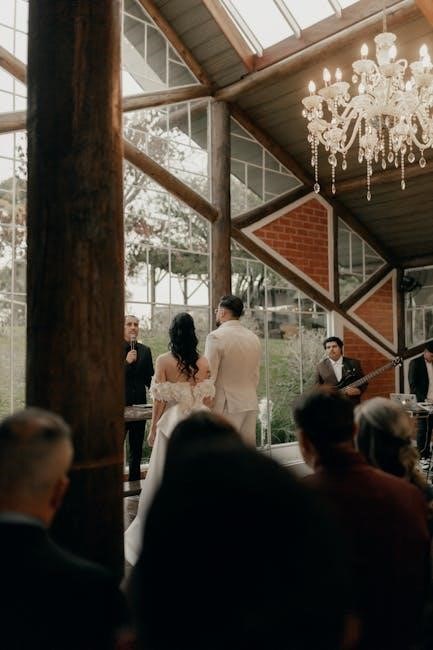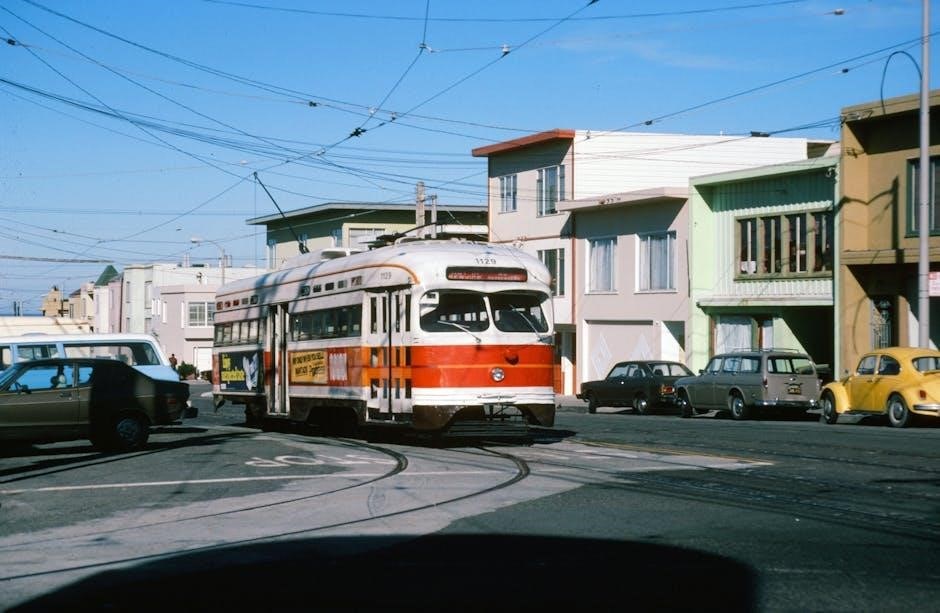glass menagerie pdf
The Glass Menagerie PDF study guides offer comprehensive summaries, in-depth analysis, and engaging quizzes to aid students in understanding the play’s themes and complex characters.
Overview of the Play
Tennessee Williams’ The Glass Menagerie is a poignant memory play revolving around the Wingfield family—Amanda, Tom, and Laura—trapped in illusions of the past. The narrative, led by Tom’s nostalgic reflections, explores themes of reality vs. illusion, family dynamics, and the fragility of hope. Williams’ lyrical prose and symbolic elements, like the glass menagerie, create a deeply emotional and introspective atmosphere. The play’s autobiographical undertones and universal themes have solidified its place as a cornerstone of American theatre, with study guides offering insights into its rich complexity and enduring relevance.
Historical Context of the Play
The Glass Menagerie, written by Tennessee Williams, is set in St. Louis during the Great Depression, reflecting the economic and social struggles of the 1930s. The play mirrors Williams’ own family experiences, offering a deeply personal yet universally relatable portrayal of a dysfunctional family navigating poverty and disillusionment. Its autobiographical elements and exploration of societal challenges resonate with audiences, making it a timeless reflection of the era’s hardships and the human condition.
Significance of the Title “The Glass Menagerie”
The title “The Glass Menagerie” symbolizes Laura Wingfield’s delicate glass animal collection, representing her fragility and escape from reality. The menagerie, like Laura, is both beautiful and vulnerable, reflecting the Wingfield family’s shattered dreams and their struggle to cope with the harshness of life. The title encapsulates the play’s themes of fragility, illusion, and the impossibility of preserving a fractured reality, making it a poignant metaphor for the characters’ emotional and psychological states.

Background of Tennessee Williams
Tennessee Williams, born Thomas Lanier Williams, was a renowned playwright and novelist. His challenging childhood and personal struggles deeply influenced his writing, shaping works like The Glass Menagerie.
Biography of Tennessee Williams

Tennessee Williams, born Thomas Lanier Williams on March 26, 1911, in Columbus, Mississippi, was a celebrated American playwright and novelist. His early life, marked by frequent moves and family tensions, influenced his later work. Williams attended the University of Missouri and Washington University, developing his passion for writing. He gained fame with The Glass Menagerie in 1944, which catapulted him to prominence. His subsequent works, such as A Streetcar Named Desire, solidified his legacy as a leading figure in 20th-century American literature.
Williams’ Writing Style and Influence

Tennessee Williams’ writing style is renowned for its poetic dialogue, emotional depth, and exploration of human frailty. His works often blend realism with a lyrical, almost dreamlike quality, creating a unique theatrical experience. Williams’ influence on modern theater is immense, as he introduced complex, psychologically rich characters and themes. His ability to weave symbolism into narratives has inspired countless playwrights and remains a cornerstone of his enduring legacy in American literature and drama.
The Glass Menagerie as a Memory Play
The Glass Menagerie is a seminal memory play, narrated by Tom Wingfield, who revisits his past with poetic introspection. Williams employs non-linear storytelling, blending reality and illusion, to explore themes of nostalgia and regret. The play’s dreamlike atmosphere, enhanced by stage directions, reflects Tom’s internal struggle to reconcile his memories with the harshness of reality, making it a powerful exploration of the human psyche and the fragility of recollection.
Plot Summary and Analysis
The Glass Menagerie PDF reveals the Wingfield family’s struggles through Tom’s narration, exploring Amanda’s dominance, Laura’s fragility, and the illusion of a gentleman caller, Jim, unraveling their delicate reality.
Structure of the Play
The Glass Menagerie is a memory play narrated by Tom Wingfield, blending fragmented recollections into a cohesive narrative. Divided into two acts, the play unfolds non-linearly, reflecting Tom’s subjective memories. Key scenes, such as the dinner with Jim O’Connor and Laura’s breakdown, highlight the Wingfields’ strained relationships. The structure emphasizes illusion versus reality, with Tom’s narration bridging past and present. Set in the Wingfields’ St. Louis apartment, the confined space mirrors the characters’ emotional entrapment, while the fire escape symbolizes escape and disillusionment.
Key Scenes and Their Significance
The dinner scene with Jim O’Connor is pivotal, exposing the Wingfields’ fragile dynamics. Laura’s breakdown reveals her emotional vulnerability, while Amanda’s overbearing nature surfaces. Tom’s decision to abandon his family marks a turning point, highlighting his internal conflict. The glass unicorn’s breakage symbolizes Laura’s shattered illusions. These scenes underscore themes of memory, illusion, and the inevitability of disillusionment, making them central to the play’s emotional and thematic depth.
Themes Explored in the Play
Tennessee Williams explores themes of memory, illusion, and the American Dream in The Glass Menagerie. The play delves into the fragility of human emotions, the clash between reality and fantasy, and the suffocating nature of family dynamics. Amanda’s longing for a vanished past, Laura’s retreat into a world of glass animals, and Tom’s struggle for independence illustrate the destructive power of unfulfilled desires. These themes resonate deeply, offering a poignant reflection on the human condition and the fragility of hope.

Character Analysis
The Glass Menagerie explores complex characters like Amanda, Tom, Laura, and Jim, each embodying distinct struggles with identity, illusion, and reality, shaping the play’s emotional depth.
Amanda Wingfield: The Matriarch

Amanda Wingfield, the mother, is portrayed as a woman clinging to her past glory and societal expectations. She struggles to reconcile her fantasies with the harsh realities of her present life. Through her character, Williams illustrates the tension between illusion and reality, as Amanda often escapes into memories of her youth to cope with her family’s financial and emotional struggles. Her overbearing nature and constant reminders of her past reflect her deep-seated fears and insecurities about the future.
Tom Wingfield: The Narrator and Protagonist
Tom Wingfield serves as both the narrator and protagonist, offering a reflective and often biased perspective on his family’s life. His narration blurs the line between reality and memory, creating a dream-like atmosphere. Tom is conflicted between his loyalty to his family and his desire for independence. His role as narrator allows Williams to explore themes of memory and illusion, while Tom’s internal struggles highlight the broader tensions of familial responsibility and personal aspiration.
Laura Wingfield: The Fragile Soul

Laura Wingfield embodies the essence of fragility, both physically and emotionally. Her limp and shy demeanor symbolize her vulnerability, while her glass menagerie reflects her delicate beauty and inner world. Laura’s dependence on her mother Amanda highlights her struggle for independence, yet her gentle spirit and love for her collection reveal a quiet strength. Her character serves as a poignant reminder of the fragility of life and the power of resilience in the face of adversity.
Jim O’Connor: The Gentleman Caller
Jim O’Connor, the gentleman caller, represents hope and reality in Laura’s fragile world. His kindness and charm bring temporary joy to Laura, but his engagement elsewhere underscores the impossibility of their connection. Jim’s character symbolizes the harsh realities of life, contrasting with the Wingfields’ illusions. His presence highlights Laura’s vulnerability and the family’s struggle to reconcile their dreams with the outside world, adding layers of tragic irony to the narrative.
Themes and Symbolism
The play explores themes of memory, illusion, and the American Dream, reflecting the Wingfields’ struggle with reality and their fragile family dynamics.
Memory and Illusion
Tennessee Williams’ The Glass Menagerie masterfully explores the interplay between memory and illusion, as Tom Wingfield narrates the fragmented recollections of his family’s past. The play’s dream-like atmosphere underscores the subjective nature of memory, often distorted by emotions and longing. Amanda’s fixation on her youthful glory and Laura’s retreat into her glass menagerie illustrate the characters’ reliance on illusions to escape harsh realities. Williams uses these elements to examine the tension between reality and fantasy, revealing how memories shape yet deceive, and how illusions both comfort and confine.
The American Dream and Disillusionment
The Glass Menagerie by Tennessee Williams critiques the American Dream, presenting a family trapped in economic and emotional struggles. Amanda Wingfield’s faded Southern belle identity and Tom’s factory job reflect the unattainability of prosperity. The play highlights the illusion of social mobility, as the Wingfields cling to past glories, unable to grasp future opportunities. Williams portrays disillusionment through their failed aspirations, mirroring the broader societal collapse of the American Dream during the mid-20th century, leaving only shattered hopes and unfulfilled expectations in its wake.
Family Dynamics and Tragedy
The Glass Menagerie explores the tragic disintegration of the Wingfield family, bound by love, guilt, and unmet expectations. Amanda’s dominating yet fragile presence exacerbates the tensions, while Tom’s internal conflict between familial loyalty and personal ambition drives the narrative. Laura’s physical and emotional fragility serves as a metaphor for the family’s collective vulnerability. Their dynamics unravel into a cycle of blame and regret, culminating in a tragic inability to connect, leaving each member isolated in their own private struggles and shattered illusions.

Symbolism in the Play
The glass menagerie symbolizes Laura’s fragility and the family’s delicate emotional state, while the fire escape represents Tom’s longing to escape his confining reality and responsibilities.
The Glass Menagerie as a Symbol
The glass menagerie embodies Laura’s fragility and her escape from reality. Each animal symbolizes a part of her personality, with the unicorn representing her uniqueness and isolation. The collection’s delicacy mirrors the Wingfield family’s fractured lives, as their hopes and dreams are as breakable as the glass. The menagerie also serves as a metaphor for the past, preserved yet vulnerable, reflecting the family’s struggle to hold onto memories while facing an uncertain future.
The Fire Escape: A Symbol of Escape and Reality
The fire escape in The Glass Menagerie serves as both a literal and symbolic passage. It represents Tom’s desire to escape his suffocating home life and pursue his own future. Yet, it also underscores the impossibility of true escape, as the outside world remains harsh and unyielding. The fire escape bridges the inner, illusion-filled world of the Wingfields and the external reality, symbolizing the tension between aspiration and entrapment. It highlights the characters’ inability to fully break free from their past and emotional burdens.
The Unicorn: A Symbol of Laura’s Fragility
The unicorn in Laura’s glass menagerie symbolizes her delicate and unique nature. Its rarity and beauty mirror Laura’s own fragility and individuality. When the unicorn is broken by Jim, it reflects the shattering of Laura’s illusions and her struggle to cope with reality. The unicorn represents her inner fragility and the inevitable loss of innocence, making it a poignant reminder of her vulnerability and the harshness of the world she cannot fully embrace.

Performance History
The Glass Menagerie originally opened on Broadway in 1945. Recent productions include a 2025 London staging and a Tehran performance, showcasing its enduring appeal.
Original Broadway Production
Tennessee Williams’ The Glass Menagerie opened on Broadway at the Playhouse Theatre on March 31, 1945. Directed by Eddie Dowling and Margo Jones, it ran for 561 performances, starring Laurette Taylor as Amanda Wingfield. This production marked Williams’ rise to prominence, earning critical acclaim and the New York Drama Critics’ Circle Award. Its success solidified the play’s place in American theatre history, showcasing Williams’ unique storytelling and emotional depth.
Notable Revivals and Adaptations
The Glass Menagerie has seen numerous notable revivals and adaptations worldwide. The Iranian Artists Forum hosted a 70-minute production directed by Mohammad Berahmani and Saeed Zarei. In London, the Yard Theatre presented a version with striking aesthetic choices and a standout performance by Sharon Small. Tehran’s Arya Theater Hall featured a reading performance directed by Heliya Jolaie Moghaddam. Additionally, an Australian production by Ensemble Theatre revitalized the play for modern audiences, showcasing its enduring relevance and emotional depth. These adaptations highlight the play’s universal appeal and timeless themes.

Study Guides and Resources
Tennessee Williams Annual Review and online platforms offer detailed study guides, summaries, and analysis of The Glass Menagerie. SparkNotes and Theatrefolk provide quizzes, character insights, and thematic breakdowns, aiding deeper understanding.
SparkNotes and Theatrefolk Resources
SparkNotes offers detailed summaries, analysis, and quiz questions on The Glass Menagerie, providing insights into themes like memory and illusion. Theatrefolk complements this with exercises and guides, helping students engage deeply with the play. Both resources are designed to enhance understanding and facilitate study, making complex concepts accessible. They are invaluable tools for analyzing Tennessee Williams’ lyrical prose and the Wingfield family’s intricate dynamics, offering a comprehensive approach to studying the play’s literary elements and emotional depth.
Analysis of Literary Devices
Tennessee Williams employs vivid imagery and metaphors in The Glass Menagerie to convey the fragility of human emotions. The play’s use of memory as a narrative device creates an unreliable yet deeply emotional lens, enhancing its poignant themes. Williams’ lyrical prose and symbolic elements, such as the glass menagerie itself, reinforce the tension between illusion and reality. These devices underscore the Wingfield family’s struggles, making the play a masterful exploration of human vulnerability and the power of memory to shape perception and identity.
Quiz Questions and Study Materials
The Glass Menagerie PDF study guides include detailed quiz questions to test understanding of themes, characters, and symbols. SparkNotes and Theatrefolk provide comprehensive materials, featuring multiple-choice questions and essay prompts. These resources cover key scenes, character motivations, and Williams’ use of memory as a narrative device. Quizzes focus on identifying literary devices, analyzing dialogue, and exploring the play’s historical context. Study materials also offer practice exams and discussion topics to prepare students for in-depth analysis and class discussions on the play’s complex themes and dramatic structure.
Tennessee Williams’ The Glass Menagerie remains a profound exploration of memory, illusion, and family dynamics. Its legacy endures, with PDF resources offering insights into its themes and symbols, solidifying its place in American theatre history.
Legacy of “The Glass Menagerie”
The Glass Menagerie has left an indelible mark on American theatre, with its poignant exploration of memory and illusion. PDF resources highlight its enduring influence, showcasing how it revolutionized storytelling in drama. The play’s ability to evoke deep emotional resonance continues to captivate audiences and inspire new adaptations. As a cornerstone of modern theatre, its legacy is preserved through scholarly analyses and study guides, ensuring its relevance for future generations of readers and performers alike.
Impact on Modern Theatre
The Glass Menagerie has profoundly influenced modern theatre, reshaping narrative techniques. PDF guides reveal how its memory play structure and poetic dialogue set new standards. Directors worldwide adapt its intimate storytelling, incorporating innovative staging. The play’s emotional depth and complex characters inspire contemporary playwrights, ensuring its timeless relevance. Its impact is evident in numerous revivals and adaptations, making it a cornerstone of theatrical innovation and a continued source of inspiration for artists globally.
Further Reading
Explore SparkNotes and Theatrefolk for in-depth The Glass Menagerie PDF guides, featuring summaries, analysis, and quizzes. Online resources offer additional articles and critical insights.
Recommended Books and Articles
For deeper insight into The Glass Menagerie, explore SparkNotes and Theatrefolk’s detailed PDF guides, which include summaries, character analyses, and thematic discussions. Tennessee Williams’ legacy is explored in Tennessee Williams: A Guide to Research and Performance, offering scholarly critiques. Articles in the Tennessee Williams Annual Review provide fresh perspectives on the play’s themes. Additionally, books like The Cambridge Companion to Tennessee Williams and Tennessee Williams’ Plays delve into the playwright’s style and influence. These resources enrich understanding of the play’s complexity and historical context;
Online Resources for Deeper Analysis
SparkNotes and Theatrefolk offer detailed PDF guides with summaries, analyses, and exercises for The Glass Menagerie. LitCharts provides in-depth analyses of themes, symbols, and characters. eNotes features study guides and expert summaries, while JSTOR offers scholarly articles for advanced research. These online resources enhance understanding of the play’s complexity, themes, and historical context, making them invaluable for students and scholars seeking a deeper exploration of Tennessee Williams’ work.





























